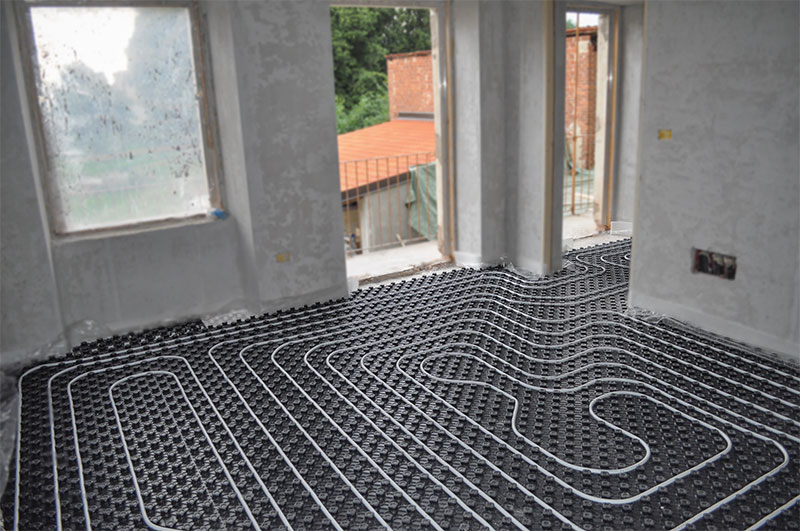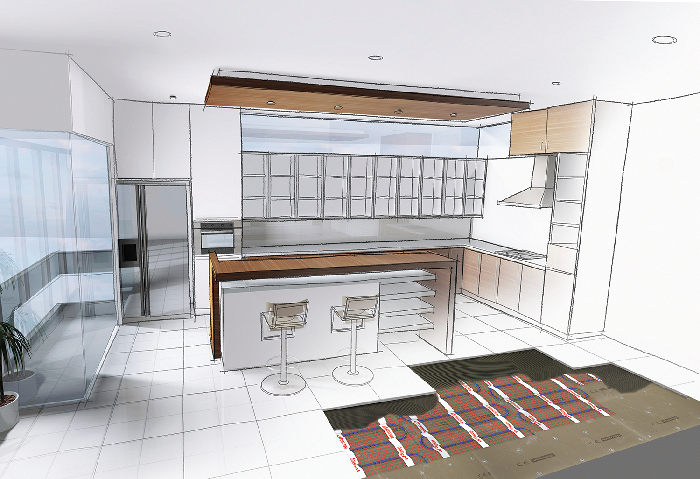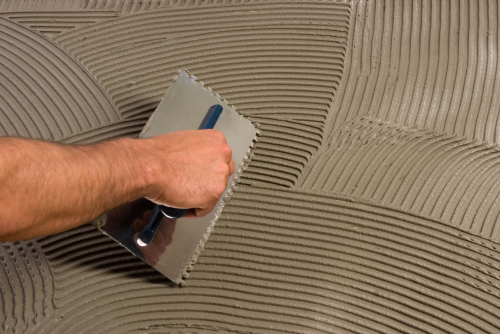Whether you have heated floors or not, your thermostat is essential to your heating and cooling system. You always want to have it in working condition, especially if you have heated flooring. Without a working thermostat, you can’t control your system. So, with that in mind, how much does it cost to replace a thermostat, and how much is a new thermostat?
Types of Thermostats
Electric radiant heating cannot simply work with any thermostat. You need one with the right voltage to handle the high voltage of your radiant system. Warmup offers thermostat options that are designed specifically to work with radiant flooring. Options include:
6iE Smart WiFi Thermostat
Warmup’s 6iE Smart WiFi Thermostat is the first radiant system controller with a smartphone touchscreen. It offers some of the most advanced technology to allow homeowners to maximize the energy efficiency of their radiant heating system. It is easy to use and offers the same SmartGeo and Early Start technology as the Terra system. Additional benefits of the 6iE thermostat include:
- Home Automation: Works with the IFTTT platform, which allows the thermostat to communicate with Amazon Alexa, Crestron, and Control 4 drivers
- Personalizable: The only radiant heating thermostat that allows you to set custom photo backgrounds
- Easy Energy Monitoring: View energy and cost graphs on your mobile devices
- Warranty: 12-year warranty
The Terra WiFi Thermostat
The Terra WiFi Thermostat is the most basic smart option. The simple, esthetic design offers great functionality. Benefits of the Terra thermostat include:
- SmartGeo Technology: Temperature will automatically go down when you leave and warm back up when you return, which can help reduce CO2 emissions by up to 25%
- Early Start Technology: Weather-based early start functionality allows the system to read the weather forecast and activate at the right time, depending on weather conditions
- Easy to Use: No complicated controls and doesn’t require programming or a complicated setup process
The main downside to the Terra thermostat is that it doesn’t offer the advanced smart features that you can find on more high-tech models.
RFT Thermostat
The RFT Thermostat is the most basic option that Warmup offers. While it is a touchscreen device, it doesn’t have WiFi capabilities and has a monochrome display. Benefits of the system include:
- Built-in GFCI protection
- No maintenance is necessary
- Can create a heating schedule
- Easy energy monitoring on smart devices
The disadvantages of the RFT thermostat include:
- SmartGeo or Early Start technology
- Shorter warranty of only 3-years
Labor Requirements for Installing a Thermostat
Before getting into the thermostat installation cost, you need to understand the labor involved in the installation process. While you can save money by installing a thermostat system yourself, it is not always recommended unless you’re a licensed electrician.
Thermostat installation is best left to professional electricians. The 6iE Smart WiFi and Terra WiFi require a permanent 110V – 240V AC, 60Hz supply. They also contain Class A GFCI trips; all wiring must meet local electrical code requirements. The RFT has a simpler installation process but is still better for a professional who understands electrical codes and wiring better. Overall, on average, the labor cost to install thermostat systems will be about $100 an hour.
Since you may need to open walls during the installation, you will have to patch your walls. A professional may charge between $3 to $8 per square foot, with most requiring a minimum fee. Holes for thermostat installation shouldn’t be too big, which makes it a project you can do yourself. You’ll still have to spend money on materials but you can save on labor. You will need:
- Drywall to fit the hole that you’re filling
- Drywall tape
- Scrap lumber, depending on the size of the hole, to support your new drywall
- Drywall screws
- Drywall joint compound
- Drywall knife
- Putty knife
- Sanding block or sheet
- Paint
Patching the drywall yourself can cost anywhere from $10 to $55, or a little more, depending on the materials you choose.
Wiring Materials
Another factor that affects the thermostat installation cost is wiring materials. If you are replacing an existing thermostat, you shouldn’t need new wiring. Installing a new thermostat or installing one in a new area will add wiring costs to consider.
The type of wiring you need depends on how far your thermostat is from the electrical panel and the distance from the thermostat to the radiant heating system.
A 12-gauge wire with positive, neutral, and ground, commonly called 12/2 wire, is standard for most 120V uses. Pricing for 12/2 wire is about $0.60 per foot and comes in roles ranging from 15-250′ long.
Wall Material
While most houses use drywall, there are also other wall materials. Different materials will affect the cost to install thermostat units.
Log homes and stone veneer are more difficult to work with and may require specialized experts with experience working with the materials, which can significantly raise the new thermostat cost. Repairing this material after the thermostat is installed is another consideration, as it will cost more and will require a professional as well.
Insulation
When opening up walls to install a thermostat, you may lose some insulation. While it will likely be minimal, it is best to replace it. Doing so will help protect against heat loss, and will help ensure that your radiant heating works at optimal levels. The insulation cost will depend on what you use and how much you need, but in general, insulation can cost between $0.17 to $5 per square foot.
Average Cost to Install Thermostat
It is difficult to determine the average cost of a new thermostat because there are many variables to consider. To determine how much is a new thermostat for your home, you need to consider:
- How much is a thermostat?
- How much wiring is required? How long will it take an electrician?
- What sort of walls do you have? How much will repairs cost?
While thermostat prices are easily found online, you will have to get estimates to understand how much you can expect to spend on everything like the labor cost to install thermostat units in your home.
Average Thermostat Replacement Cost
Determining the cost to replace thermostat units has fewer variables to consider. You’ll want to consider how much a new thermostat is and the labor required to replace the old unit.
Options like the Warmup 6iE WiFi Smart Thermostat and Terra WiFi Thermostat are great options when replacing an old unit. Both of these systems are compatible with Warmup’s various radiant flooring options, including:
The StickyMat System
The Warmup StickyMat system is an easy, quick install. It is an extremely thin and durable product. It is best for regularly shaped areas and is compatible with vinyl, carpet, timber, and even tile.
Foil Heater System
The Foil Heater System works with laminate, engineered wood, and carpet and doesn’t require a leveling compound, for a quick install process. Unlike StickyMat systems, you can adapt the Foil System to fit around objects to help ensure full heat coverage.
DCM-PRO
DCM-PRO is the only UL-approved Membrane System in North America. It offers the highest heating output and is easy to cut to fit into your space as needed. You want to pair this system with the 6iE Smart thermostat for the night efficiency potential.
Radiant Heating: A Worthy Investment
Radiant heating systems offer a great return on investment; they can increase your home’s value and bring significant energy savings, especially paired with a smart thermostat. This all makes an excellent return on investment, which makes them well worth the cost of installation.
To learn more, contact us today to learn more about everything Warmup has to offer and the cost to replace thermostat units in your home!




